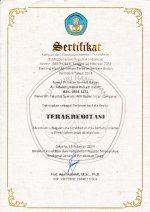Domestic Violence in The Perspective of Civil and Islamic Criminal Law
Abstract
Keywords
Full Text:
PDFReferences
Bibliography:
Addieningrum, F, M. (2019). Efforts to Handle Wives of Victims of Domestic Violence (KDRT) (Analytical Study at the Batam City Religious Court in 2019). STAI Journal of Sharia Economic Law Vol.XV No.2.
Agil Fatkhurohmah, et al. (2023). Legal Protection for Women Victims of Domestic Violence in Divorce Cases. Islamic Family Law Research Journal (JRHKI). Volume : 3 No. : 1. Pages : 52-55.https://doi.org/10.29313/jrhki.vi.2154.
Andi Rahmah and Samsiar Arief. (2018). Implementation of Penal Mediation in Resolving Domestic Violence (KDRT) Cases. PETITUM, Vol. 6, No. 1.
Anggraeni and Ardianto. (2020). How the Police Handle Domestic Violence (KDRT) Cases: Semarang Police Case Study. International Journal of Demos. Volume 2 Issue 3.https://doi.org/10.37950/ijd.v2i3.68.
Author's interview with interviewee from the Bandung Religious Court (M. Adli Hakim H, SH as Judicial Case Analyst). October 6, 2023.
Author's interview with interviewee of the PPA unit (Protection of Women and Children) of the Bandung Police Criminal Investigation Unit (IPDA Cecep Suhendra, SH as Head of PPA Sub-Nit). October 18, 2023.
Azkia, S, and Andriasari, D. (2023). Case Study of Domestic Violence at the Bandung Police Station Viewed from the Aspects of Criminal Law and Criminology. Legal Research Journal (JRIH). Vol. 3 No. 1. Pages : 55-62.https://doi.org/10.29313/jrih.v3i1.2139.
Cahya Wulandari. (2020). Legal philosophy review: the participatory paradigm for violence against women in central java. Justisia Volume 9 Number 1 . Pg 83-97.
Dani Sandra. (2019). Integrated Service Post (PPT) as a Communicator of Domestic Violence Cases (Case Study of Character and Attribute PPT as a Communicator of Domestic Violence Cases in Surakarta). International Journal of Multicultural and Multireligious Understanding. Vol. 6, no. 6. Pg 588-599.
Erniyanti, et al. (2021). Divorce settlement due to home violence during the pandemic Covid 19 in Medan City. International Journal Of Social, Policy And Law (IJOSPL). Vol. 2 No. 3. Pages 54-62.
Firdos, et al. (2021). Paralegal training for legal assistance for victims of domestic violence Stairs in the Jayengan village, Serengan sub-district, Surakarta city. JPM Independent Service Journal. Vol.1, No.6
Helmi, M, I. (2014). Special Domestic Violence Court. Center for Constitutional and Legislative Studies. UIN Syarif Hidayatullah Jakarta.
https://bandungbermobil.id/article/detail/988/data-kekerasan-terhadap-anak-di-kota-bandung-2020-terbesar-berupa-kekerasan-psikis.
Husein, A, R. (2021). Role of damang (tribal chief) on domestic violence (study at Palangka Raya City, Indonesia). Journal of Law and Legal Reform. 2(3), pp. 365-376.https://doi.org/10.15294/jllr.v2i2.46534.
Jamaa, La, Hadidjah. (2007). Islamic Law and the Anti-Domestic Violence Law. Surabaya: PT Bina Ilmu.
Kusmardani, Safe'i, Syarif. (2022). Factors that cause divorce from a family law perspective between Islamic schools of thought and social reality. JSIM: Journal of Social Sciences and Education Vol. 3, no. 3 : 177-193.
National Commission on Women. (2022). Shadows of Stagnation: The Power of Prevention and Treatment Against the Increase in Number, Variety and Complexity of Gender-Based Violence Against Women CATAHU 2022: Annual Records of Violence Against Women in 2021. Jakarta: National Commission on Violence Against Women.
National Commission on Women. (2023). Violence Against Women in the Public and State Realms: Lack of Protection and Remedies CATAHU 2023: Annual Records of Violence Against Women in 2022. Jakarta: National Commission on Violence Against Women.
Lesnussa, Supusepa, Latumaerissa. (2021). Crime of Domestic Violence According to the Study of Law Number 23 of 2004 concerning the Elimination of Domestic Violence. TATOHI Journal of Legal Studies Vol 1, No 5: 474-480.
Martha, Aroma, Elmina. (2013). The Process of Legal Formation of Violence Against Women in Indonesia and Malaysia. Yogyakarta: Aswaja Pressindo.
Muzainah, G. (2023). Divorce Contribution During the Covid-19 Pandemic in Banjarmasin City. Kawanua International Journal of Multicultural Studies Vol. 4, no. 1. p. 41-51.https://doi.org/10.30984/KIJMS.v4i1.554.
Salma, et al. (2017). Legal protection for women and children (analysis of judges' decisions regarding madhiyah livelihood in religious courts in West Sumatra). Istinbáth Journal of Islamic Law/Journal of Islamic Law vol. 16, no. 1. p. 1-264.
Sidiq Aulia. (2019). Handling of Domestic Violence (KDRT) Cases by the Community Empowerment and Women's Empowerment Plan (BKBPMPP) of Sleman Regency. University of Bengkulu Law Journal, Volume 4 Number 2. Pages 152-170.
Shofwatun, F. (2021). Legal Protection of Domestic Workers Who Are Victims of Domestic Violence in Banyumas Regency. Faculty of Law – Muhammadiyah University Purwokerto Vol. 2 No. 1.
Sukardi. (2015). Study of Domestic Violence in the Perspective of Islamic Law and Positive Law. Court Vol. 9 No. 1 (January-June): 41-49.
Sutiawati and Jasmaniar. (2023). Domestic Violence and the Pandemic: A Review of the Effectiveness of Legal Protection for Victims. UNES Law Review. Vol. 6, no. 1.https://doi.org/10.31933/unesrev.
Sutiawati and Mappaselleng. (2020). Prevention of Violent Crime in Indonesia
Households in Makassar City. Journal of Juridical Insights Vol. 4 No. 1.https://doi.org/10.25072/jwy.v4i1.315.
Sukendar, S, et al. (2023). Women's Access To Justice Mediation For The Victims Of Domestic Violence In Central Java. Samarah: Journal of Family Law and Islamic Law Volume 7, No. 1.
Syarifuddin. Law Enforcement Against Perpetrators of Crimes of Domestic Violence (Research Study at the Medan Police). LEGAL JOURNAL OF LEGAL COMMUNICATION AND INFORMATION Media Law and Society. Volume : 20, Number : 2.
Wahyudi and Suhartono. (2020). Legal Protection for the Rights of Children Who Are Victims of Domestic Violence is Linked to Law Number 35 of 2014 concerning Amendments to Law Number 23 of 2002 concerning Child Protection. Journal of Legal Dialectics Vol. 2 No.1.
Wulandari, L. Policy for handling domestic violence through penal mediation.
DOI: http://dx.doi.org/10.24042/adalah.v20i2.19438
Refbacks
- There are currently no refbacks.
Copyright (c) 2023 Usep Saepullah, Eva Nur Hopipah
Al-'Adalah is licensed under a Creative Commons Attribution-ShareAlike 4.0 International License.



.png)
_(1).png)
_(1).png)

.png)
